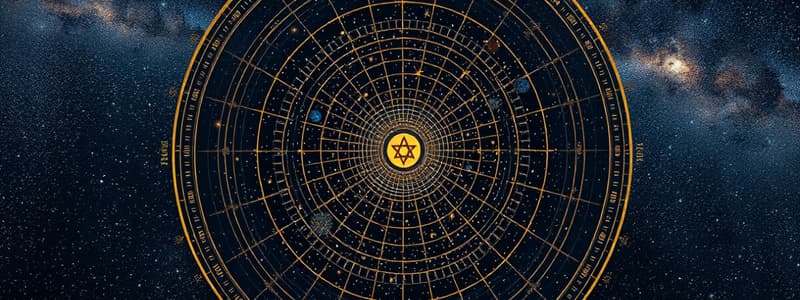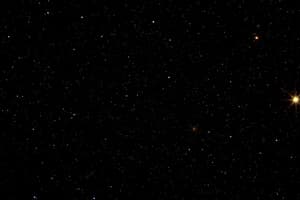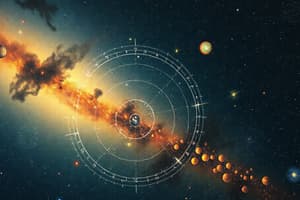Podcast
Questions and Answers
Where on the HR Diagram are the Blue Giants located?
Where on the HR Diagram are the Blue Giants located?
Top Left
Where on the HR Diagram are the Red Giants and Super-giants located?
Where on the HR Diagram are the Red Giants and Super-giants located?
Top Right
Where on the HR Diagram are the White Dwarfs located?
Where on the HR Diagram are the White Dwarfs located?
Bottom Left
Where on the HR Diagram are the Main Sequence stars located?
Where on the HR Diagram are the Main Sequence stars located?
What does the HR Diagram show?
What does the HR Diagram show?
Where would our star the Sun be located?
Where would our star the Sun be located?
Where on the HR Diagram are the hottest stars located?
Where on the HR Diagram are the hottest stars located?
Where on the HR Diagram are the coolest stars located?
Where on the HR Diagram are the coolest stars located?
Where on the HR Diagram are the brightest stars located?
Where on the HR Diagram are the brightest stars located?
Where on the HR Diagram are the dimmest stars located?
Where on the HR Diagram are the dimmest stars located?
Which star types on the HR Diagram are the hottest stars?
Which star types on the HR Diagram are the hottest stars?
Which star types on the HR Diagram are the coolest stars?
Which star types on the HR Diagram are the coolest stars?
What is another word for luminosity?
What is another word for luminosity?
Who is the HR Diagram named for?
Who is the HR Diagram named for?
What is the highest temperature on the HR Diagram?
What is the highest temperature on the HR Diagram?
What is the lowest temperature on the HR Diagram?
What is the lowest temperature on the HR Diagram?
Which star types on the HR Diagram are the brightest stars?
Which star types on the HR Diagram are the brightest stars?
Which star types on the HR Diagram are the dimmest stars?
Which star types on the HR Diagram are the dimmest stars?
How is a star's color related to its temperature?
How is a star's color related to its temperature?
What is the general relationship between temperature and brightness?
What is the general relationship between temperature and brightness?
What relationship do you see between star color and star temperature?
What relationship do you see between star color and star temperature?
Where is our Sun located on the H-R Diagram?
Where is our Sun located on the H-R Diagram?
What spectral class does our Sun belong to?
What spectral class does our Sun belong to?
What is the size of our Sun?
What is the size of our Sun?
A star is classified as being in a spectral class B. What is its color?
A star is classified as being in a spectral class B. What is its color?
A star is classified as being in a spectral class B. What is its temperature?
A star is classified as being in a spectral class B. What is its temperature?
We know dwarfs are smaller than our Sun. How can they be so bright?
We know dwarfs are smaller than our Sun. How can they be so bright?
Which star is the brightest white dwarf?
Which star is the brightest white dwarf?
Which star is the hottest supergiant?
Which star is the hottest supergiant?
What color is Deneb?
What color is Deneb?
What temperature is Sirius B?
What temperature is Sirius B?
What temperature is Bernard's Star?
What temperature is Bernard's Star?
Which star is the dimmest (less bright) on the chart?
Which star is the dimmest (less bright) on the chart?
What category is the hottest star on the chart?
What category is the hottest star on the chart?
What spectral class is represented by the star Sirius A?
What spectral class is represented by the star Sirius A?
What spectral class is represented by the star Procyon B?
What spectral class is represented by the star Procyon B?
What spectral class is represented by the star Capella?
What spectral class is represented by the star Capella?
What spectral class is represented by the star Arcturus?
What spectral class is represented by the star Arcturus?
Flashcards are hidden until you start studying
Study Notes
HR Diagram Overview
- The HR Diagram represents the relationship between stars' temperature and brightness.
- Temperature is plotted on the horizontal axis, while brightness (luminosity) is on the vertical axis.
Star Locations on the HR Diagram
- Blue Giants: Located at the top left, indicating high brightness and high temperature.
- Red Giants and Supergiants: Found at the top right, characterized by high brightness but lower temperatures.
- White Dwarfs: Positioned at the bottom left, showing low brightness and high temperature.
- Main Sequence Stars: Occupy the middle of the diagram, including the Sun.
Temperature and Brightness
- Hottest stars are found on the left side; light emitted is mostly blue and ultraviolet.
- Coolest stars are on the right side, emitting red and infrared light.
- Brightest stars are at the top, while the dimmest are at the bottom.
Star Classification
- Stars are categorized into types based on temperature and brightness:
- Hottest Stars: Blue Giants and White Dwarfs.
- Coolest Stars: Red Giants and some Main Sequence stars.
- The Sun is classified as a G2 type star and is a medium-sized star located in the middle of the HR Diagram.
Temperature Ranges
- Highest temperature on the HR Diagram is 70,000°F (40,000 K).
- Lowest temperature recorded is 4,000°F (2,500 K).
Color and Temperature Relationship
- Star color indicates temperature: blue or white stars are the hottest; red stars are cooler.
- The frequency of light emitted correlates to the star's temperature.
Spectral Classes
- B Class: Blue, with a temperature of 31,000 K.
- Notable spectral classes: Rigel (B), Betelgeuse (M), Sirius A (A), Procyon B (F), Capella (G), Arcturus (K).
Specific Stars
- Sirius B: Brightest white dwarf star with a temperature of 9,940 K.
- Conopus: Hottest supergiant star.
- Deneb: Recognized for its blue-white color.
- Betelgeuse: Noted as a red giant.
- Bernard's Star: Identified as the dimmest star on the diagram.
Additional Insights
- Stars classified as white dwarfs can be extremely bright due to their high temperatures, despite their smaller sizes.
- The majority of stars in the universe are classified as Main Sequence stars.
Studying That Suits You
Use AI to generate personalized quizzes and flashcards to suit your learning preferences.




